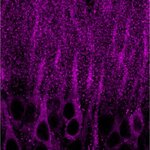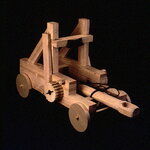Applied Physics

A collaboration of University of Pennsylvania chemists and engineers has performed multi-scale modeling of ferroelectric domain walls and provided a new theory of behavior for domain-wall motion, the "sliding wall" that separates ferroelectric domains and makes high-density ferroelectric RAM (FeRAM) possible.
The new theory, supported by a novel modeling study developed specifically for this research, confirms experimental data long at odds with existing theories of domain-wall behavior. Most notable is that, Penn's simulations reproduced experimental domain growth rates and revealed small,…

Is using a Wii too much workout for you? Developers at the University of Washington may have something you like better. Designed for people with disabilities, their new software lets users control a computer cursor without any tactile involvement. Early tests suggest that an experienced user of Vocal Joystick would have as much control as someone using a handheld device.
"There are many people who have perfect use of their voice who don't have use of their hands and arms," said Jeffrey Bilmes, a UW associate professor of electrical engineering. "I think there are several reasons why Vocal…

Not literally aspirin, but researchers at the Boyce Thompson Institute for Plant Research (BTI) say methyl salicylate (MeSA), an aspirin-like compound, alerts a plant's immune system to shift into high gear.
It has long been known that plants often develop a state of heightened resistance, called systemic acquired resistance, following pathogen infection; this phenomenon requires the movement of a signal from the infected leaf to uninfected parts of the plant. Until now, however, no one knew what that signal was.
"Now that we have identified a signal that activates defenses throughout the…

Evolution has mastered the art of turning trash to treasure - though, for scientists, witnessing the transformation can require a bit of patience. In new genetic research, scientists have traced the 170 million-year evolution of a piece of “junk” DNA to its modern incarnation as an important regulator of energy balance in mammals.
The discovery, they said, suggests that regions of the genome formerly presumed to be a genetic junkyard may actually be a hardware superstore, providing components that can be used to evolve new genes or new species.
The discoveries were reported by Howard Hughes…

Computer and behavioral scientists at the University at Buffalo say they are working on a system to compute a numerical score that determines the likelihood that someone is about to commit a terrorist act. Their technology will track faces, voices and other biometrics against scientifically tested behavioral indicators to provide that numerical score for an individual.
“The goal is to identify the perpetrator in a security setting before he or she has the chance to carry out the attack,” said Venu Govindaraju, Ph.D., professor of computer science and engineering at the University at Buffalo…
University of Utah scientists discovered a strange method of reproduction in primitive plants named cycads: The plants heat up and emit a toxic odor to drive pollen-covered insects out of male cycad cones, and then use a milder odor to draw the bugs into female cones so the plants are pollinated.
The unusual form of sexual reproduction used by some species of cycads – primeval plants known as “living fossils” – may represent an intermediate step in the evolution of plant pollination, the researchers say.
“People think of plants as just sitting there and looking pretty and sending out some…

In a report this week in Cell, researchers have identified a biological basis for why events that happen during heightened states of emotion such as fear, anger and joy are more memorable than less dramatic occurrences: a hormone released during emotional arousal “primes” nerve cells to remember events by increasing their chemical sensitivity at sites where nerves rewire to form new memory circuits.
Describing the brain as a big circuit board in which each new experience creates a new circuit, Johns Hopkins neuroscience professor Richard Huganir says that he and his team found that, during…

Researchers at UCLA have developed a model that could help engineers and scientists speed up the development of hydrogen-fueled vehicles by identifying promising hydrogen-storage materials and predicting favored thermodynamic chemical reactions through which hydrogen can be reversibly stored and extracted.
The new method, published in Advanced Materials, was developed by Alireza Akbarzadeh, a UCLA postdoctoral researcher in the department of materials science and engineering; Vidvuds Ozolins, UCLA associate professor of materials science and engineering; and Christopher Wolverton, professor…

Neural prosthetic devices represent an engineer's approach to treating paralysis and amputation. Electronics are used to monitor the neural signals that reflect an individual's intentions for the prosthesis or computer they are trying to use. Algorithms form the link between neural signals that are recorded, and the user's intentions that are decoded to drive the prosthetic device.
These brain-controlled prosthetics, usable by people who cannot move or speak, won't be here any time soon but MIT researchers have developed a new algorithm that could help convert brain signals into action in…

We all know about the advanced machines of the ancient Greeks, like the water pumps and the steam engines devised by their greatest minds, but what is less known is how those with little theoretical background were still able to make well-calibrated devices with alarming precision.
Recent analysis of technical treatises and literary sources dating back to the fifth century B.C. reveals that technology flourished among practitioners with limited theoretical knowledge.
“Craftsmen had their own kind of knowledge that didn’t have to be based on theory,” explains Mark Schiefsky, professor of the…